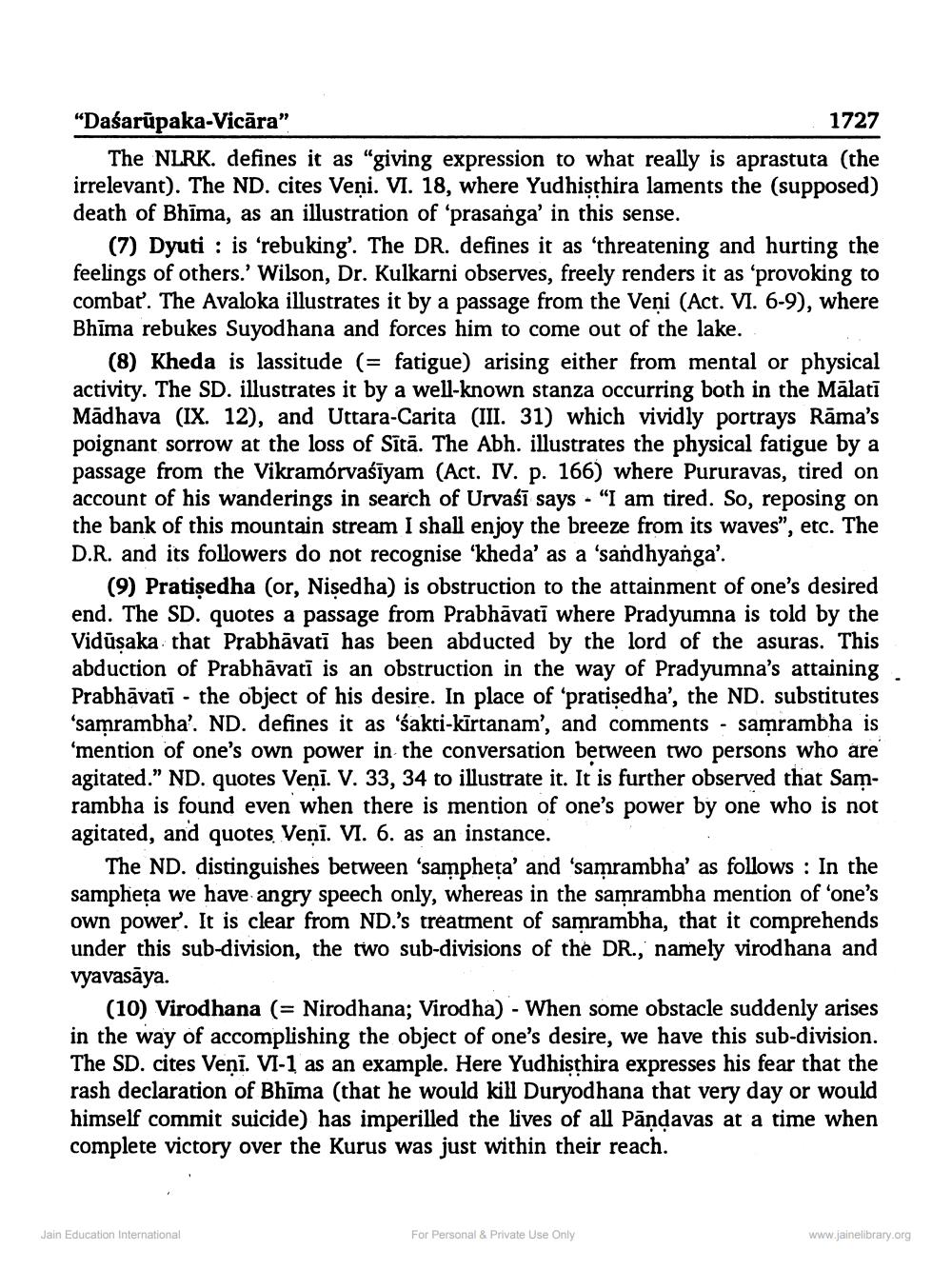________________
"Dasarūpaka-Vicāra"
1727 The NLRK. defines it as "giving expression to what really is aprastuta (the irrelevant). The ND. cites Veni. VI. 18, where Yudhisthira laments the (supposed) death of Bhīma, as an illustration of 'prasanga' in this sense.
(7) Dyuti : is 'rebuking'. The DR. defines it as 'threatening and hurting the feelings of others.' Wilson, Dr. Kulkarni observes, freely renders it as 'provoking to combat'. The Avaloka illustrates it by a passage from the Veni (Act. VI. 6-9), where Bhīma rebukes Suyodhana and forces him to come out of the lake.
(8) Kheda is lassitude (= fatigue) arising either from mental or physical activity. The SD. illustrates it by a well-known stanza occurring both in the Malati Mādhava (IX. 12), and Uttara-Carita (III. 31) which vividly portrays Rāma's poignant sorrow at the loss of Sitā. The Abh. illustrates the physical fatigue by a passage from the Vikramórvašīyam (Act. IV. p. 166) where Pururavas, tired on account of his wanderings in search of Urvaśī says - "I am tired. So, reposing on the bank of this mountain stream I shall enjoy the breeze from its waves", etc. The D.R. and its followers do not recognise 'kheda' as a 'sandhyanga'.
(9) Pratisedha (or, Nisedha) is obstruction to the end. The SD. quotes a passage from Prabhāvati where Pradyumna is told by the Vidūsaka that Prabhāvati has been abducted by the lord of the asuras. This abduction of Prabhāvati is an obstruction in the way of Pradyumna's attaining Prabhāvati - the object of his desire. In place of 'pratiședha', the ND. substitutes samrambha'. ND. defines it as 'sakti-kīrtanam', and comments - samrambha is 'mention of one's own power in the conversation between two persons who are agitated." ND. quotes Veni. V. 33, 34 to illustrate it. It is further observed that Samrambha is found even when there is mention of one's power by one who is not agitated, and quotes. Veni. VI. 6. as an instance.
The ND. distinguishes between 'sampheta' and 'samrambha' as follows : In the sampheta we have angry speech only, whereas in the samrambha mention of 'one's own power. It is clear from ND.'s treatment of samrambha, that it comprehends under this sub-division, the two sub-divisions of the DR., namely virodhana and vyavasāya.
(10) Virodhana (= Nirodhana; Virodha) - When some obstacle suddenly arises in the way of accomplishing the object of one's desire, we have this sub-division. The SD. cites Venī. VI-1 as an example. Here Yudhisthira expresses his fear that the rash declaration of Bhima (that he would kill Duryodhana that very day or would himself commit suicide) has imperilled the lives of all Pandavas at a time when complete victory over the Kurus was just within their reach.
Jain Education International
For Personal & Private Use Only
www.jainelibrary.org




